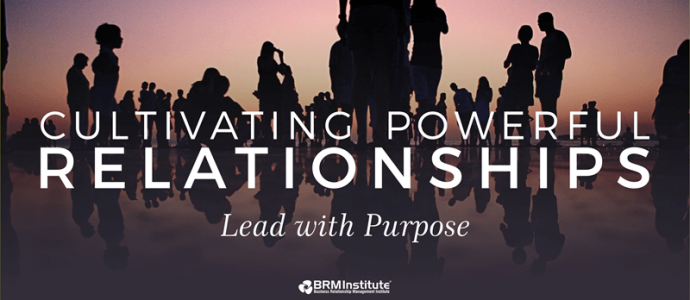Cultivating Powerful Relationships: Lead with Purpose

Consider, for a moment, the ways your organization impacts society directly and indirectly. Reflect on everything it touches–the people it serves, the families it supports, the resources it consumes–and the legacy (read: ‘purpose’) of your organization. As a leader or an executive, would you be proud of the impact created by your organization if it ended tomorrow?
To help you reflect on such a weighty question, take a look at the previous two articles in the “Cultivating Powerful Relationships” series:
If you missed the prequels to this article, here’s a helpful summary of the topics explored:
All human beings thrive in a balanced state when two things are present – a strong individual purpose and harmonious relationships. Likewise, when organizations nurture relationships with one another and know their purpose, society functions more cohesively creating positive impact.
Additionally, the BRM capability channels the power of compassion inward to build partnering relationships within organizations. For BRMs – operating as connector, orchestrator, and navigator – cultivating a compassionate mindset is critical to progressing in your role and advancing the BRM capability. If you cultivate compassion within yourselves and among your teams, even the most toxically competitive organization can evolve into one that fosters collaboration, innovation, and trust.
Now, back to the question you asked yourself earlier. If you answered with anything less than a resounding ‘yes’ with 100% certainty, it may be time to reflect on your organization’s purpose.
Purpose, Relationships, Culture…Oh, My!
To understand the connection between your organization’s purpose, culture, and its respective relationships might be overwhelming at first glance. The simplest and most logical place to start is to understand your organizational purpose as the context for the entire network of relationships, both inside and out.
Purpose is the primary motivator to effective work relationships. When your organization’s purpose for existence is recognized as “good” by customers, employees, and investors, all relationships alike have the greatest chance of developing. Here are a few key reasons why:
- A compelling purpose acts as a stabilizer to the organization’s culture, helping it become more resilient to the ever-changing set of work relationships.
- Purpose guides hard decisions which demonstrates its authenticity to customers, employees, and investors, serving as a secure foundation in the relationships between them.
- Purpose is the reason to exist forever, if it is well thought out.
Without a clearly defined organizational purpose, there is no context for effective work relationships to develop and drive value. Learn more about how to drive value for your organization with the resources available in the BRM Interactive Body of Knowledge (BRMiBOK).
Next, you’ll want to examine your organization’s culture and whether or not it supports your purpose.
Culture: Your Purpose Catalyst or Crutch
To better understand how culture impacts your organization’s purpose, think of your organization’s culture as a reflection of its network of work relationships. This includes past and present relationships having anything to do with your organization. This means the culture you see present today in your organization didn’t just materialize. It was cultivated over time by people and their relationships with one another.
With this in mind, notice how an organization’s culture can either reinforce or override your purpose as the context for current and future relationships.
Since culture is an accumulation of current and past relationships, and great relationships are powerful influencers, an organization’s culture ultimately fuels its value creation. However, the fuel may be bad or good.
- An organization with built-up silos and dysfunctional relationships between territorial owners has bad fuel and value creation will be difficult.
- An organization with relationships based on shared ownership and a compelling purpose has good fuel to innovate and drive value.
It’s important to understand, to affect the culture of an organization is to affect the relationships between people. Relationships are the true lever to evolving culture. It is not guesswork or random luck. It’s relationship management.
Building Lasting Partnerships
Without a compelling organizational purpose for people to unify behind, you’re leaving the “why” up to chance. As a leader, if you’ve noticed your organizational culture is toxic and value-depleting, consider if the reason your organization exists is clear and compelling to all who interact with it. Has it been communicated effectively to gain people’s belief in it?
If the context of all the work relationships is not built on a solid foundation, how can you expect the relationship to be effective?
Many of these issues are addressed by advancing a business relationship management (BRM) capability within your organization. The end result is a drive towards collaboration and a culture of creativity, innovation, and value that reflects the organizational strategy as a whole.
The best place for organizational leaders and executives to begin with better managing their network of relationships is the BRM Executive Brief. This course is geared toward CEOs, executives, and other business leaders looking to gain knowledge of why and how to leverage their BRM capability to move business functions and external partners to converged strategic partners and drive exponential results consistently across industries.
Still have questions or want to learn more?
The upcoming free webinar series, The Knowledge Path to Success, will highlight everything you need to know about the BRM Executive Brief. You’re in store for an insightful, educational panel discussion on each available knowledge offering suited for your specific needs. You’ll hear stories from past students and facilitators highlighting their “aha” moments and what you can expect from each individual class.

[…] a copywriter for organizations such a the BRM Institute, printed an article lately known as “Cultivating Powerful Relationships: Lead with Purpose“. The important thing phrase right here is the phrase “objective”. And the […]
[…] copywriter for organizations such a the BRM Institute, published an article recently called “Cultivating Powerful Relationships: Lead with Purpose“. The key word here is the word “purpose”. And the key takeaway is the importance […]